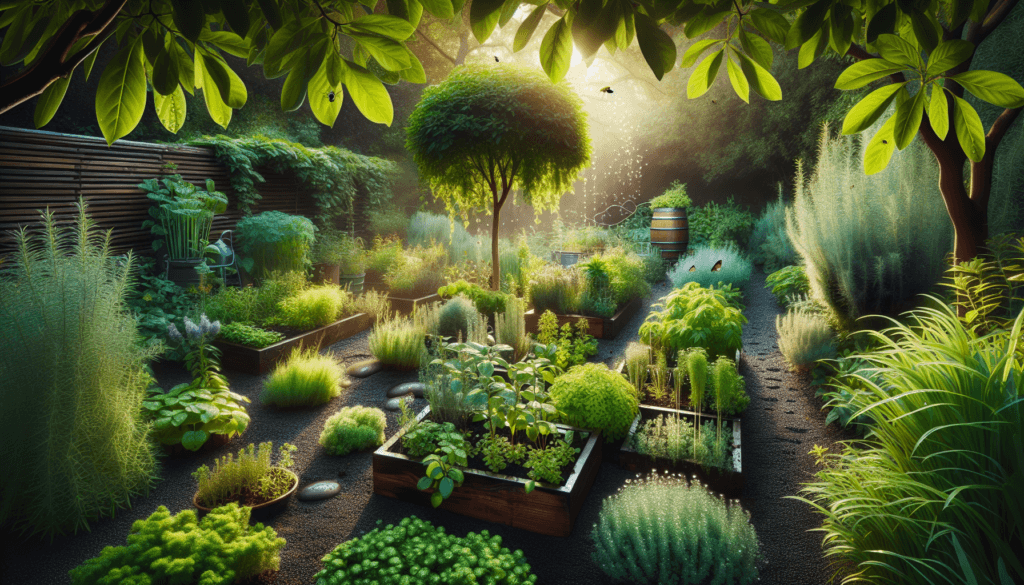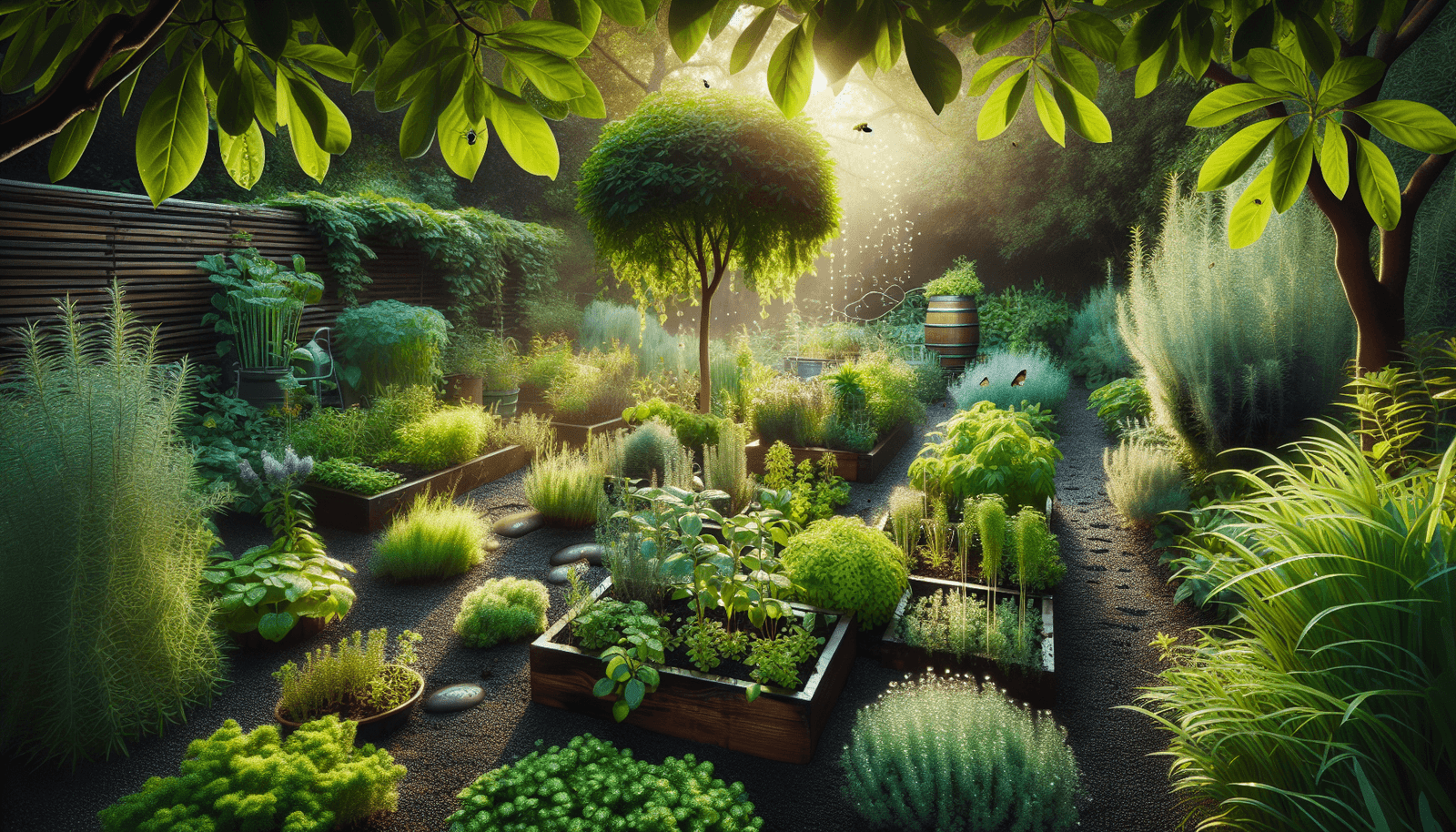Are you interested in creating your own herb garden but don’t know where to start? Look no further! This article will provide you with all the necessary steps and tips on how to create a sustainable herb garden. From choosing the right location to selecting the perfect herbs, we’ve got you covered. Whether you’re a seasoned gardener or a complete beginner, this guide will help you on your journey to growing your own fresh and flavorful herbs in an eco-friendly and sustainable way. So grab your gardening gloves and let’s get started!

Choosing the Right Location
Assessing Sun and Shade
To create a sustainable herb garden, the first step is to choose the right location. Assessing the amount of sun and shade in your garden is essential, as it will determine which herbs will thrive in that particular spot. Most herbs require at least 6 hours of sunlight per day, so it’s important to select an area that receives adequate sun exposure. Observing your garden throughout the day and taking note of areas that receive full sun, partial shade, or full shade will help you make an informed decision.
Considering Drainage
Another important factor to consider when choosing the location for your herb garden is drainage. Herbs generally prefer well-draining soil and can be susceptible to root rot if the soil is overly saturated. Take note of any areas in your garden that tend to hold water after rainfall, as these areas may not be suitable for planting herbs. Ideally, you want to select a location with good drainage to ensure the longevity and health of your herbs.
Identifying the Best Soil Type
Different herbs have different soil preferences, so it’s crucial to identify the soil type in your garden. Some herbs, such as lavender and rosemary, prefer sandy or loamy soil, while others, like mint and parsley, thrive in moist and fertile soil. Testing the pH level of your soil will give you a better understanding of its acidity or alkalinity, which can help you determine the right herbs to grow. Additionally, if your soil doesn’t meet the requirements of the herbs you want to cultivate, you can amend it with organic matter to improve its quality.
Selecting the Right Herbs
Deciding on Culinary or Medicinal Herbs
Before choosing which herbs to grow in your garden, it’s important to decide whether you want to focus on culinary herbs, medicinal herbs, or a combination of both. Culinary herbs, such as basil, thyme, and oregano, are commonly used in cooking to add flavor to various dishes. On the other hand, medicinal herbs, like chamomile and echinacea, have healing properties and can be used to make teas or natural remedies. Understanding your preferences and intended use for the herbs will guide your selection process.
Researching Herbs Suitable for Your Climate
Different herbs thrive in different climates, so it’s crucial to research which herbs are suitable for your specific climate zone. Some herbs, like rosemary and sage, prefer hot and dry conditions, while others, such as mint and parsley, thrive in cooler and more humid environments. Understanding the climatic requirements of herbs will help you choose the ones that are most likely to thrive in your garden, making them more sustainable in the long run.
Considering the Growth Requirements of Each Herb
Each herb has specific growth requirements, including soil pH, moisture levels, and sunlight exposure. When selecting herbs for your sustainable garden, take into consideration the growth requirements of each herb and how they align with the conditions in your garden. For instance, if you have a sunny spot with well-draining soil, you can choose herbs like lavender and rosemary that thrive in such conditions. By matching the growth requirements of herbs to the conditions in your garden, you increase the chances of their long-term success.
Preparing the Soil
Testing the soil pH
Before planting your herbs, it’s essential to test the pH level of your soil. Most herbs prefer a slightly acidic to neutral pH range, around 6.0 to 7.0. Testing kits are readily available at gardening stores and can help you determine the current pH level of your soil. If the pH level is not within the optimal range for your desired herbs, you can make adjustments by adding either lime to raise the pH or sulfur to lower it. Ensuring that your soil has the correct pH will help the herbs absorb nutrients efficiently and promote healthy growth.
Amending the Soil with Organic Matter
To create a sustainable herb garden, it’s important to improve the quality of your soil by adding organic matter. Organic matter, such as compost or well-rotted manure, helps to enhance soil structure, moisture retention, and nutrient content. Before planting your herbs, incorporate a generous amount of organic matter into the soil, ensuring that it is evenly distributed. This will provide a nutrient-rich environment for the herbs to thrive, reducing the need for synthetic fertilizers and promoting sustainability.
Creating Raised Beds or Containers for Improved Drainage
If your garden has poor drainage or you want to have more control over the soil conditions, consider creating raised beds or using containers for your herb garden. Raised beds elevate the planting area, allowing for better drainage and minimizing the risk of soil compaction. Containers, such as pots or troughs, can be filled with well-draining soil that is specially formulated for herbs. This gives you the flexibility to move the herbs to different locations and ensures optimal growing conditions. Both raised beds and containers also help to prevent the spread of invasive herbs, promoting sustainability in your garden.
Planting Your Herb Garden
Determining Spacing and Layout
When planting your herbs, it’s important to consider their mature size and growth habits. Some herbs, like basil and cilantro, have a bushy habit and require more space, while others, like thyme and oregano, have a spreading habit and can be planted closer together. Research the specific spacing requirements for each herb and plan the layout of your herb garden accordingly. Proper spacing helps to prevent overcrowding, improves airflow, and reduces the risk of diseases.
Sowing Seeds or Transplanting Seedlings
You have two options when it comes to starting your herb garden: sowing seeds or transplanting seedlings. Sowing seeds directly into the soil allows you to witness the complete lifecycle of the herb, from germination to maturity. Transplanting seedlings, on the other hand, provides a head start and allows you to skip the germination stage. Consider the time, effort, and resources you have available when deciding which method to use. Whichever option you choose, ensure that the herbs are planted at the appropriate depth and gently water them after planting to settle the soil.
Watering and Mulching
Proper watering is crucial for the growth and sustainability of your herb garden. Different herbs have different water requirements, so it’s important to research the specific needs of each herb. In general, herbs prefer slightly moist soil, but overwatering can lead to root rot and other issues. Ensure that you water your herbs deeply, allowing the water to penetrate the root zone, but avoid excessive watering. Mulching around your herbs helps to conserve moisture, suppress weeds, and regulate soil temperature. Organic mulches, such as straw or wood chips, are ideal for sustainable herb gardens.

Providing Proper Care
Regular Watering and Fertilizing
Once your herb garden is established, regular watering and fertilizing are essential for its continued health and productivity. Water your herbs consistently, keeping the soil evenly moist but not waterlogged. Fertilize your herbs with organic fertilizers, such as compost or well-rotted manure, to provide a balanced supply of nutrients. Avoid using synthetic fertilizers, as they can lead to nutrient imbalances and harm beneficial soil organisms. Regular watering and proper fertilization will support the sustainable growth of your herbs throughout the growing season.
Pruning and Harvesting Herbs
Pruning and harvesting your herbs not only encourage their growth but also promote sustainability. Regular pruning helps to maintain the size and shape of the herbs, prevents them from becoming leggy, and improves airflow, reducing the risk of diseases. When harvesting herbs, choose the appropriate time of day, typically in the morning when the essential oils are at their peak. Use clean, sharp scissors or pruning shears to make clean cuts just above a leaf node. Proper pruning and harvesting techniques will ensure the continuous production of fresh and healthy herbs.
Monitoring for Pests and Diseases
In any garden, pests and diseases can pose a threat to plant health and sustainability. Monitor your herb garden regularly for signs of pests, such as aphids or caterpillars, and diseases, such as powdery mildew or leaf spots. Early detection allows for prompt action and minimizes the need for harsh chemical treatments. Whenever possible, opt for organic pest control methods, such as introducing beneficial insects or using natural sprays like neem oil. By actively monitoring and managing pests and diseases, you can maintain a healthy and sustainable herb garden.
Encouraging Pollinators and Beneficial Insects
Choosing Pollinator-Friendly Plants
Pollinators, such as bees and butterflies, play a crucial role in the reproduction of herbs and other plants. To create a sustainable herb garden, choose plants that attract pollinators and provide them with a source of nectar. Herbs like lavender, thyme, and salvia are known to attract bees and butterflies with their vibrant flowers and sweet fragrance. Planting a variety of pollinator-friendly plants throughout your garden will not only enhance its beauty but also support the local ecosystem and promote sustainability.
Creating Bee-friendly Habitats
Bees are important pollinators and are essential for the health and fertility of your herb garden. Creating a bee-friendly habitat involves providing them with suitable nesting sites and a consistent source of food. Install bee houses or leave areas of your garden undisturbed where bees can burrow and lay their eggs. Avoid using chemical pesticides or herbicides that can harm bees and other beneficial insects. By creating a bee-friendly environment, you can ensure the long-term sustainability of your herb garden.
Avoiding Harmful Chemicals
To maintain a sustainable herb garden, it’s crucial to avoid using harmful chemicals that can have detrimental effects on the environment and beneficial insects. Chemical pesticides and herbicides can not only harm pests but also impact pollinators, birds, and other wildlife. Instead, opt for organic pest control methods, like companion planting or applying natural sprays made from ingredients like garlic or chili pepper. By avoiding harmful chemicals, you can protect the delicate balance of your herb garden and promote sustainability.

Conserving Water
Installing a Rainwater Collection System
Conserving water is an essential aspect of creating a sustainable herb garden. One way to do this is by installing a rainwater collection system. This system allows you to collect and store rainwater from the roof of your house or other structures. Collected rainwater can then be used to water your herb garden, reducing the demand for treated tap water. Rainwater is not only free but also contains natural minerals that benefit plant growth. By implementing a rainwater collection system, you can minimize water waste and contribute to a more sustainable garden ecosystem.
Using Drip Irrigation or Soaker Hoses
Another water-saving technique for your herb garden is to use drip irrigation or soaker hoses. These systems deliver water directly to the root zone of plants, minimizing evaporation and ensuring efficient water usage. Drip irrigation allows for precise watering, reducing the risk of water runoff and promoting water conservation. Soaker hoses, which release water slowly along their length, are an excellent option for herb beds or containers. By adopting these water-saving methods, you can conserve water while maintaining optimal moisture levels for your herbs.
Watering Strategically
Strategic watering is key to conserving water in your herb garden. Instead of watering on a fixed schedule, observe your herbs and water them when they show signs of thirst. For instance, if the soil feels dry to the touch or the herbs appear wilted, it’s time to water. Deep watering, where you thoroughly moisten the soil to encourage deep root growth, is more effective than frequent shallow watering. Watering early in the morning or late in the evening also helps to reduce water loss due to evaporation. By watering strategically, you can conserve water and promote the sustainability of your herb garden.
Controlling Weeds Naturally
Mulching with Organic Materials
Weeds not only compete with herbs for nutrients and sunlight but can also harbor pests and diseases. Mulching with organic materials is an effective and sustainable way to control weeds in your herb garden. Organic mulches, such as straw, wood chips, or shredded leaves, act as a natural barrier, preventing weed seeds from germinating and smothering any existing weeds. Apply a layer of mulch around your herbs, ensuring that the soil is covered but not touching the plant stems. This not only helps to control weeds but also conserves soil moisture and promotes healthy plant growth.
Hand Weeding Regularly
Regular hand weeding is an essential practice to maintain a weed-free herb garden. Take some time each week to inspect your herb beds and containers, removing any visible weeds by hand. It’s important to pull weeds from the root to prevent regrowth. Remember to wear gloves to protect your hands and ensure that you are not pulling out any desirable herbs by mistake. By incorporating regular hand weeding into your routine, you can keep weeds under control and maintain the sustainability of your herb garden without the use of harmful chemicals.
Avoiding the Use of Chemical Herbicides
Chemical herbicides may effectively control weeds but can be harmful to the environment, beneficial insects, and your overall garden ecosystem. To create a sustainable herb garden, it’s best to avoid using chemical herbicides altogether. Instead, focus on preventive measures like mulching and hand weeding as mentioned earlier. Persistent weeding and maintaining a healthy growing environment for your herbs will minimize weed growth naturally. Embrace the concept of sustainable weed control by avoiding the use of chemical herbicides and applying organic methods instead.

Managing Pests and Diseases Organically
Encouraging Natural Predators
Maintaining a balanced ecosystem is key to managing pests and diseases in your herb garden. Encouraging natural predators, such as ladybugs, lacewings, and birds, helps control common herb garden pests like aphids and caterpillars. Planting flowers that attract these beneficial insects, such as marigolds or daisies, provides them with a food source and habitat. Additionally, consider leaving small piles of twigs or rocks to create shelter for insects and attracting birds that feed on pests. By fostering a diverse and healthy ecosystem, you can reduce pest populations naturally and promote sustainability.
Applying Organic Pest Control Methods
If pest populations become a concern in your herb garden, there are several organic pest control methods you can employ. For example, using homemade sprays made from ingredients like garlic or chili pepper can deter pests without harming beneficial insects. Neem oil, derived from the neem tree, is also an effective organic pest control option. Another method is companion planting, where you interplant herbs that repel pests with susceptible plants. Research which herbs have pest-repellent properties and strategically plant them throughout your herb garden. By applying organic pest control methods, you can protect your herbs while maintaining a sustainable garden environment.
Implementing Crop Rotation
Crop rotation is an age-old practice that helps prevent the buildup of pests and diseases in your herb garden. Rotating herbs within different areas or beds from one year to the next disrupts the life cycles of pests and diseases. It also helps to balance nutrient depletion and maintain soil health. Additionally, rotating herbs can prevent the spread of diseases that are specific to certain plant families. Keep a record of where each herb is planted and create a schedule for rotation to maximize the sustainability and productivity of your herb garden.
Harvesting and Preserving Herbs
Harvesting in the Morning
Timing is crucial when it comes to harvesting herbs. The best time to harvest herbs is in the morning, after any dew has dried but before the heat of the day. At this time, the essential oils that give herbs their flavors and aromas are at their peak. Using clean, sharp scissors or pruning shears, carefully cut off the desired parts of the herbs just above a leaf node. Avoid harvesting more than one-third of the plant at a time to ensure its continued growth and productivity. Harvesting in the morning maximizes the flavor and quality of your herbs, making them a sustainable and enjoyable addition to your culinary endeavors.
Drying Herbs for Storage
Drying herbs is a traditional method of preserving their flavors and extending their shelf life. To dry herbs, tie small bunches together at the stems and hang them upside down in a well-ventilated area away from direct sunlight. This allows the herbs to dry naturally while retaining their aromatic properties. Once the herbs are completely dry, remove the leaves from the stems and store them in airtight containers, away from light and moisture. Properly dried herbs can last for months, providing you with a sustainable supply of flavors for your culinary creations throughout the year.
Freezing or Making Herb-infused Oils
If you prefer to preserve your herbs in a more versatile form, freezing or making herb-infused oils are excellent options. To freeze herbs, finely chop or mince them and place them in ice cube trays filled with water or olive oil. Once frozen, transfer the herb cubes into freezer-safe bags or containers. This method allows you to easily add the herbs to your dishes while retaining their flavors. Alternatively, you can create herb-infused oils by heating a carrier oil, such as olive or grapeseed oil, with your chosen herbs. Strain out the herbs and store the infused oil in airtight containers. Frozen herbs and herb-infused oils provide convenient and sustainable ways to enjoy your herbs long after the growing season has ended.
By following these comprehensive steps, you can create a sustainable herb garden that not only provides you with fresh and flavorful herbs but also supports the health of the environment. From choosing the right location and herbs to properly caring for your plants and preserving your harvest, every step contributes to the long-term sustainability of your herb garden. Embrace the natural beauty and benefits of herbs while making a positive impact on the planet by creating your very own sustainable herb garden.



